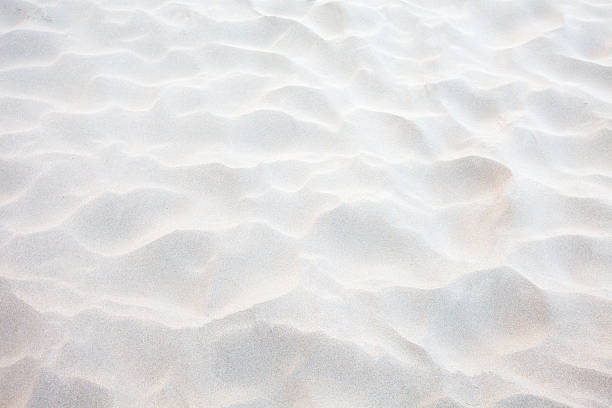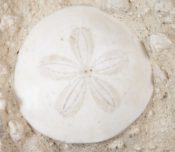
Myrtle Beach History Timeline First Settlers to Present
Introduction: Myrtle Beach Timeline
“From its earliest days as a sleepy logging village and the construction of its first hotel to the closing of the Pavilion and the revitalization of Broadway at the Beach, our area has experienced great change during the past 100+ years.
When the Burroughs and Collins Company of Conway helped build the first railroad line to a village called New Town near the turn of the 20th century, there’s no way anyone could have imagined the area — later named Myrtle Beach — would grow into one of the premier vacation destinations in the U.S. Exceeding even the wildest expectations for this once humble resort town, Myrtle Beach has expanded outward in every direction adding thousands of high-rise hotels, golf courses, eateries and attractions.
Since having developed a reputation as a place for families throughout the “golden era” of wholesome fun in the 1950s, 60s and 70s, the Grand Strand has spent the past several decades carefully walking the line between the traditions our area is known for and a desire to draw more visitors with bigger, better and newer attractions.
In an effort to pay homage to both the old and new of Myrtle Beach things to do, we’ve created this timeline looking back at the history of the area’s development and tourism. What’s below is by no means an exhaustive exploration of our history, but rather a snapshot collection — compiled from a variety of sources — of some of the key events, openings and closings that have impacted our beloved beach.”
Videos
Early History
The first settlers of ‘The Land
The first recorded history of the Myrtle Beach area begins with Native Americans, who were the first inhabitants of the area now known as Myrtle Beach. These tribes lived in the region for thousands of years prior to the arrival of Europeans and called it “Chicora” meaning “the land”.
1521
About 600 Spanish settlers led by Lucas Vazquez de Ayllon arrived at what is now Hobcaw Barony (just south of Myrtle Beach near Georgetown) with intentions of creating the first permanent settlement in North America. After a few months, the settlement failed and the remaining 150 settlers returned to Hispaniola.
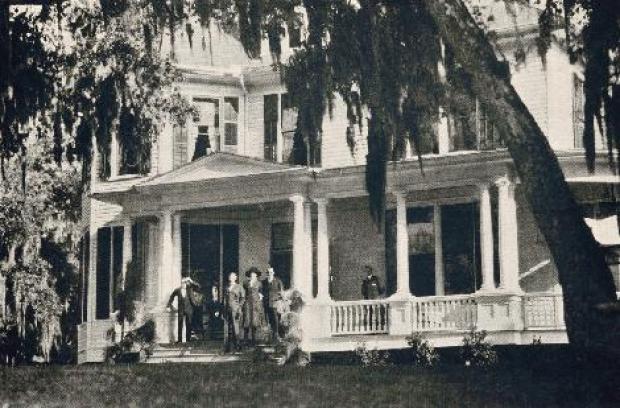
Hobcaw Barony • Source: The Belle W. Baruch Foundation
1600
It is estimated that about 900 Native Americans lived in the area. River-dwelling tribes such as the Waccamaw and Winyah inhabited the coast from North Carolina’s Lake Waccamaw to Winyah Bay near Georgetown, S.C. A strong concentration of these tribes lived in the area now known as Dog Bluff, an area of Horry County near Aynor that serves as the tribal grounds for The Waccamaw Indian People of Conway today.

Waccamaw Indians • Source: Waccamaw National Wildlife Refuge
1670
The first permanent settlement in the Carolinas is founded by English settlers in Charles Towne (now Charleston, S.C.). By 1716, an English/Native American trading post en route to Charles Towne was established at Hobcaw Barony.

18th Century
Land grant helps area take shape
Though it now belongs to hundreds and thousands of different private landowners, businesses and corporations, much of the Grand Strand once belonged to a single person ().
In the early 1700s, a landowner named Robert Francis Withers Allston receives a 66,000-acre King’s grant for much of modern Myrtle Beach. Robert and his wife operated a plantation overlooking the tidal creek now known as Withers Swash before he became a state representative and the 67th governor of South Carolina.
1716-1718
With rice and indigo cultivation thriving at plantations across the area and large-scale shipments being traded and delivered by boat, the seas soon became full of pirates. The most famous of these was Edward Teach (a.k.a. Blackbeard) and his 40-gun ship The Queen Anne’s Revenge, which pillaged numerous vessels during “The Golden Age of Piracy” up until Teach’s capture in 1718.

1721
The port city of Georgetown, the southernmost point of the Grand Strand, is founded. It is South Carolina’s third-oldest city.

1740
William Gause, one of the area’s earliest innkeepers opens a tavern for travelers along the old King’s Highway in the Windy Hill area in modern North Myrtle Beach. On his Southern tour in 1791, President George Washington visited the Carolina Coast (), spending time at William Gause’s inn and also stopping to spend the night at Brookgreen Plantation with owner Dr. Henry Collins Flagg and his wife, Rachael Moore Allston.
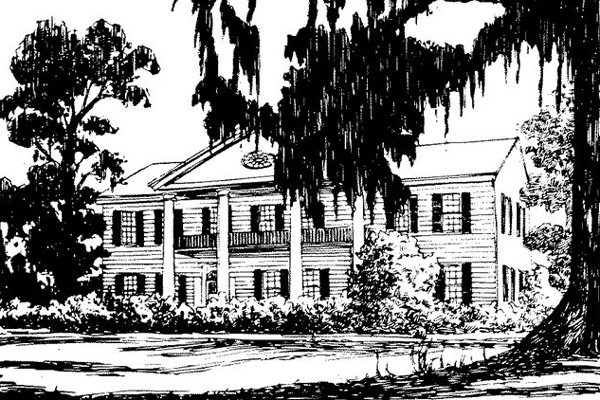
19th Century
Rice plantations and railroad expansion
During the 1800s, agriculture began to thrive throughout the Grand Strand, with the southern portions — then known as the Georgetown District — becoming prominent rice growing areas. It’s in the later part of the century that the first Eurpoean settlers arrive in the Myrtle Beach area, looking to extend an already-successful system of rice plantations.
1822
A strong hurricane hits the area — then known as Long Bay — and sweeps the house of Robert Francis Withers Allston into the ocean, drowning 18 people inside.

1840
By 1840, the Georgetown District produces nearly half of the total United States’ rice crop () and the City of Georgetown becomes the largest rice-exporting port in the world.
1881
Burroughs & Collins Company of Conway — predecessor of modern day Burroughs & Chapin Co. — purchases land that would become Myrtle Beach from the Withers family. The area’s first post office, Withers post office, opens seven years later in 1888.

1899
The Burroughs & Collins Company receives a charter to build the Conway Seashore Railroad from the South Carolina General Assembly. The line is completed around the turn of the century connecting Conway to the beach.

Early 20th Century
Railroads and roads pave the way
At the turn of the 20th century, the first trains began running from Conway to New Town on the new Conway & Seashore Railroad. This allowed Burroughs & Collins Co. to transport timber to and from the area near the beach and begin moving away from dealing in timber byproducts — such as turpentine — which was waning in value.
The line, which helped establish our area as a viable place for industry, was later called the Conway Coast and Western Railroad (1904) and became part of the Atlantic Coast Line Railroad in 1911.
1901
The Seaside Inn, the area’s first hotel, is built. At that time, oceanfront lots sold for $25 (), and buyers received an extra lot if they built a house valued at $500 or more. The hotel is later demolished in the late 1920s.
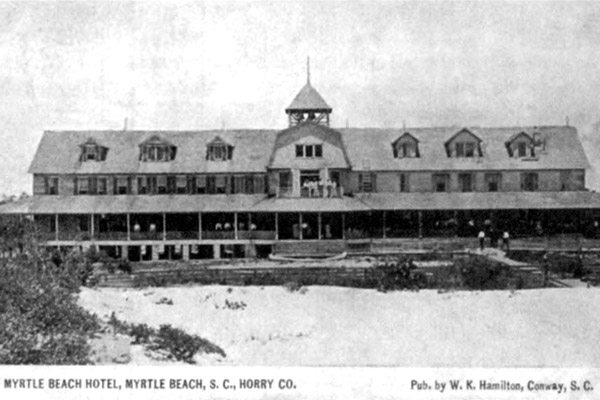
1907
The Horry Herald sponsors a contest to officially name the New Town area. Mrs. F.E. Burroughs wins the contest with the name “Myrtle Beach,” which she chose for the many wax myrtle trees growing wild along the shore.

1908
The first Myrtle Beach Pavilion is built. It is a one-story wooden structure that was constructed as part of the Seaside Inn property. This structure would later burn to the ground and be replaced by a larger version.

1912
The Burroughs & Collins Company’s beach development efforts are rolled into a new entity called the Myrtle Beach Farms Company.
Even as others such as John T. Woodside and Myrtle Beach Estates began to grab up much of the property around the area, Myrtle Beach Farms retained key portions of downtown — about 1,300 acres — including the Pavilion area and surrounding beach between Third Avenue North and Ninth Avenue North.

1914
The first road for automobiles, a sand road which runs through the area now known as Socastee, is built between Conway and Myrtle Beach. Later this year, the Town of Aynor in western Horry County is incorporated for the first time.

The 1920s
Pavilions, Piers, Pine Lakes & more
As the “Roaring 20s” became a prosperous time for much of the United States, the first signs of what was to come began popping up around the Grand Strand.
As landmarks such as piers, hotels and golf courses came to be, the framework for a thriving resort town was laid during this decade.
1923
After the first structure was lost in a fire, the Myrtle Beach Pavilion is rebuilt in 1923. The two-story wooden structure is larger than the original and sits oceanfront between what is now 8th and 9th Avenues North downtown. It would be gradually improved over the years and was expanded in 1938 before being hit with another fire in 1944.

The second Myrtle Beach Pavilion as pictured in 1938.
1926
Ocean Drive Pavilion opens in North Myrtle Beach. In Myrtle Beach, the first iteration of 14th Avenue Pier in Myrtle Beach is built. Since its original incarnation the structure — which now is a popular restaurant and fishing spot — has been destroyed and reconstructed twice, including most recently after Hurricane Hugo in 1989.

1927
The “Granddaddy” of Myrtle Beach golf courses, Pine Lakes Country Club opens as Ocean Forest Golf Course & Country Club. The club originally was home to a 27-hole course, but it was changed to an 18-hole layout in 1946.
Also in 1927, the Pleasant Inn is built along Broadway Street in Myrtle Beach.

1928
Chapin’s Department Store opens in downtown Myrtle Beach. Around this time the first Myrtle Beach High School is dedicated and a grass landing strip near the current Mr. Joe White Avenue & Seaboard Street begins to function as the area’s first airport.

1929
Myrtle Beach’s first road, which still exists today along Highway 15 and Broadway Street, is paved with rock and asphalt.
The 1930s
Myrtle Beach makes it official
Growth in tourism and population continued at a steady pace throughout the 1930s, with many changes coming to the Myrtle Beach area late in the decade — including its official incorporation.
The downtown area also continued to develop with the addition of amusement park rides near the Pavilion area and a paved, concrete walkway replacing the former wooden boardwalk.
1930
One of Myrtle Beach’s first resorts, the Ocean Forest Hotel opens for business. The 10-story hotel cost nearly $1 million to build. The area’s first miniature golf course opens at the corner of U.S. 17 (Kings Highway) and 9th Avenue North.

1931
Construction begins on Atalaya, an elaborate home built in the Spanish style of Moorish architecture by Archer and Anna Huntington. The castle, completed in 1933, is still open to the public inside Huntington Beach State Park.

1932
The Myrtle Beach Colored School is built. It is the first facility in the area dedicated to educating African-American residents.

1935
The Myrtle Beach News newspaper begins printing. The paper would later merge with the Myrtle Beach Sun to become The Sun News, which remains the area’s only daily newspaper today and is now owned by the McClatchy Tribune company.
1936
As building begins to boom at the beach, area transportation gets a boost with construction completed on the Intracoastal Waterway and the opening of the Myrtle Beach Train Depot.
In addition, Second Avenue Pier is built and Myrtle Beach’s First Theatre, Ben’s Broadway Theater, opens.

1937
One of the cornerstones of the downtown landscape for decades to come, Peaches Corner restaurant opens.
Around the same time, the Gloria Theatre (later called the Fox Theatre) opens on 9th Avenue North.

1938
Myrtle Beach is officially incorporated as a town () with Dr. W.L. Harrelson serving as the first mayor. Though no one would have expected an eventual explosion of high-rise hotels and family-friendly attractions, signs of growth were already strong.
The same year, The Original Pawleys Island Rope Hammock Shop in Pawleys Island and Washington Park Racetrack open in Myrtle Beach.
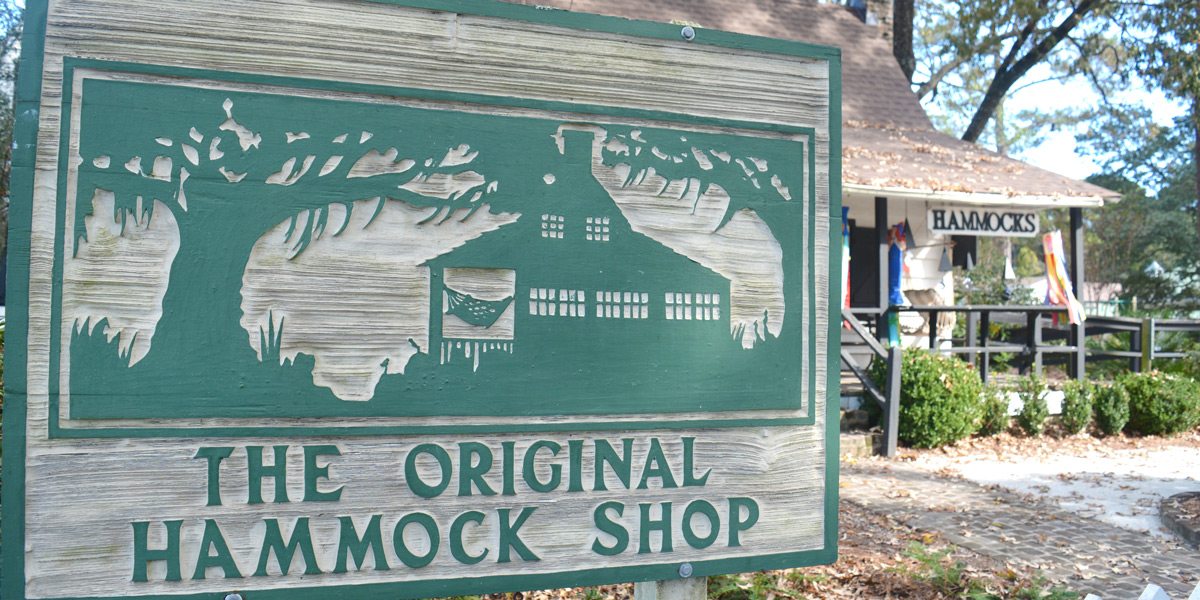
The 1940s
Local landmarks begin to pop up
In the 1940s, Myrtle Beach’s development as a recreational paradise took a back seat, as the tragic realities of World War II dominated much of the decade for people around the globe.
As the government began to use the new Myrtle Beach Airport is a training grounds, airplane crews, hangars and landing strips became the focus.
But despite the preoccupation with war, important developments took place locally during this period including the addition the area’s first highways, U.S. 501 and Kings Highway, as well as a new downtown pavilion.
1940
Kings Highway, an old trading trail used since the days of the Native Americans, is paved giving the area its first major highway.
Other additions include the first-ever Myrtle Beach Bike Week event held in the Murrells Inlet area and the Rainbow Court Hotel, which opens in Myrtle Beach.

1942
Myrtle Beach General Bombing and Gunnery Range — later known as Myrtle Beach Army Air Field and Myrtle Beach Air Force Base — is established as a training base for World War II. After the war ends it continues to be used as a front-line USAF base throughout the Vietnam War, Cold War and Persian Gulf War.

The entrance to the Myrtle Beach Air Force Base. • Source: Brandon Plyler Sales Co.
1944
The Bowery, a no-frills honky tonk bar opens in downtown Myrtle Beach. The bar has played home to many musical acts over the decades including future country music Hall of Famers Alabama from 1973 to 1980 ().

1946
The Chesterfield Inn opens in downtown Myrtle Beach. The once-popular oceanfront hotel was listed on the national Register of Historic Places in 1996, but was later removed and demolished to make way for Shark Attack Mini Golf and Hammerhead Bar & Grill.

1947
Horse racing is outlawed at Washington Park Racetrack, which once resided at the corner of Oak Street and 21st Avenue North (near the current Myrtle Beach Convention Center). The track featured a 5,200-seat grandstand and a one-and-a-half-mile, wooden-railed course that hosted horse, harness and later NASCAR racing.

1948
Several staples of the local landscape take shape as Gay Dolphin Gift Cove, Dunes Golf & Beach Club and Chapin Memorial Library open in Myrtle Beach.
The same year, Ye Olde Tavern in downtown Myrtle Beach is bought by Johnny Burroughs and renamed as the Ocean Front Grill. The bar, one of the area’s oldest is now known as Oceanfront Bar & Grill and has been by the same family for nearly 70 years.
The Myrtle Beach Pavilion Amusement Park opens after a traveling carnival in town for Conway’s Tobacco Festival signed an agreement with Myrtle Beach Farms to make its permanent home across the street from the old Myrtle Beach Pavilion. In 1949, The Myrtle Beach Pavilion building, which had been burnt down and been rebuilt several times, is reinforced with concrete built to withstand winds up to 150 mph.
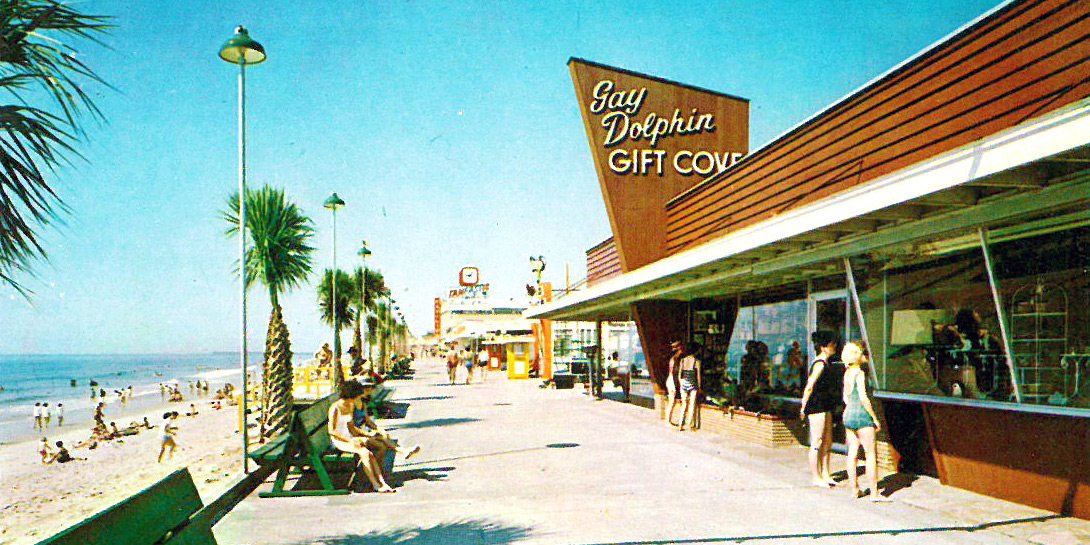
1949
The nickname “The Grand Strand” () is coined by writer Claude Dunnagan as a title for a newspaper column.
Also, Springs Industries, owners of a local mill opens an oceanfront resort for its employees called Springmaid Beach Resort — the resort opens to the public in 1953.

The 1950s
Myrtle Beach becomes a city
Entering the 1950s, the year-round population of Myrtle Beach had doubled over the past decade and with this growth in population came the expansion the of area’s infrasturcture.
Throughout the decade, as the country’s wealth and love of leisure expanded, rapid growth continued in the area with the addition of many tourism-based businesses including hotels, campgrounds, golf courses and restaurants. The most noticeable sign of this growth came late in the 1950s, when Myrtle Beach officially became a city.
1951
Two of the area’s longest-running events begin. The Sun Fun Festival is founded as a way to celebrate the beginning of the tourist season, while the first Canadian-American Days Festival is held to honor our many visitors from the Great White North.

1952-58
Miss South Carolina Pageant is held in Myrtle Beach with famous local author Mickey Spillane on the judges panel. Several of the winners in these contests went onto further success () including Mary Griffin (1952), a 1st-runner up in Miss USA 1953 representing Myrtle Beach, Miriam Stevenson (1953), who won Miss Universe 1954 and Marian McKnight (1956), who was Miss America the same year.
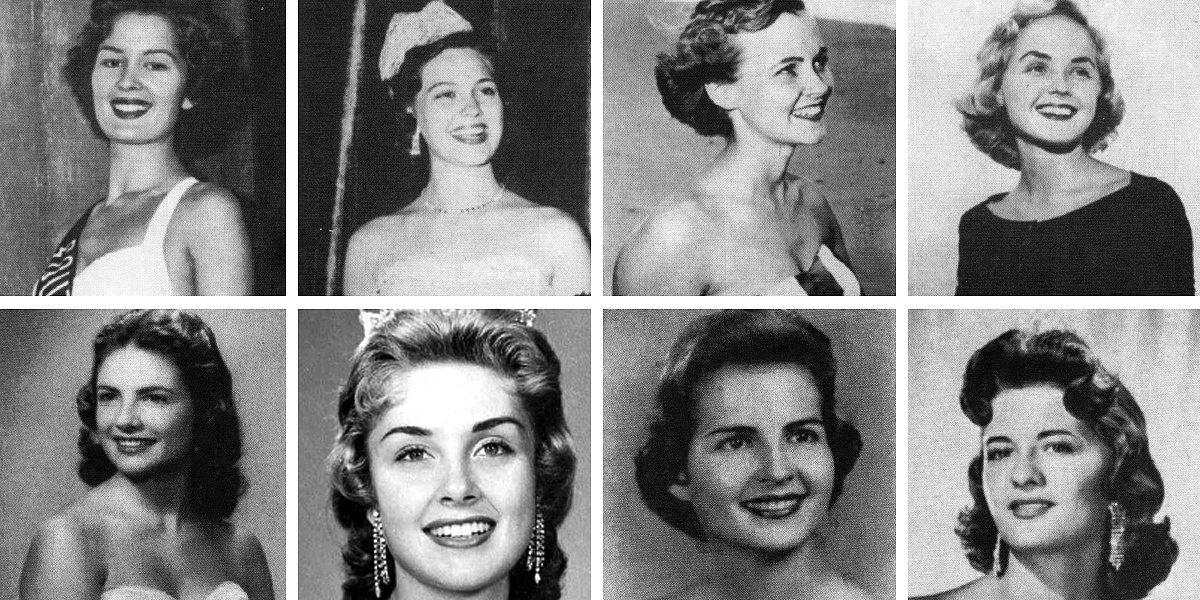
1953
Popular downtown eatery Mammy’s Kitchen opens for business in Myrtle Beach, while Surfside Pier is built in nearby Surfside Beach.

1954
Hurricane Hazel ravages The Grand Strand, destroying many local businesses and wiping out several landmarks, including piers and portions of the boardwalk. In all, the storm killed 95 people in the U.S. and caused $420 million in total damages.
The same year, Sports Illustrated magazine created () by a group of Time Magazine employees on retreat at Pine Lakes Country Club in Myrtle Beach.

1955
The Pad Shag Club in North Myrtle Beach opens. This popular hangout was a hotbed for teens and local nightlife, thriving during the golden age of “The Shag” (South Carolina’s official state dance). It was said that townspeople insisted that latticework be added over the lower portion of the building to prevent anyone from inadvertently seeing the risque moves happening inside.
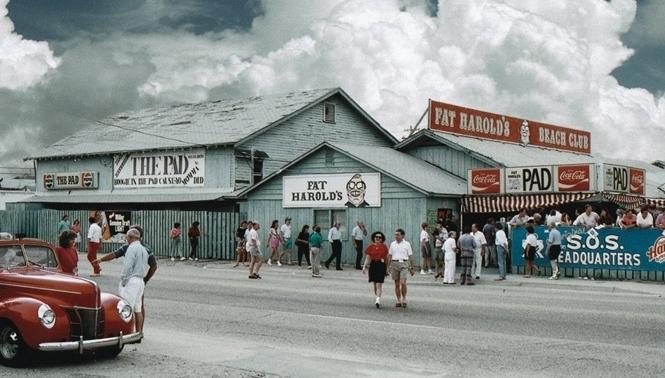
1957
In a big year for Myrtle Beach, the town becomes officially designated as a city, with population growing to more than 5,000 residents.
The city is also featured on the cover of Saturday Evening Post — the first of two appearances — providing national exposure for the area as a vacation destination.
In North Myrtle Beach, the current Ocean Drive Pavilion structure is built.

1958
Rambi Raceway dirt track opens. The raceway was later paved and renamed Myrtle Beach Speedway.
The Rivoli Theater opens on Chester Street in downtown Myrtle Beach on June 19, 1958. The first movie shown here was “This Happy Feeling” starring Debbie Reynolds.
Also, Ocean View Hospital opens in Myrtle Beach.

1959
The Diplomat Family Motel opens on Ocean Boulevard. Though the three-story oceanfront motel pales in comparison to the beach’s more modern high-rises, it was recently renovated and remains in operation to this day.
The same year, construction begins on Surf Golf & Beach Club in North Myrtle Beach, which opens for play in 1960.

1960s
The ‘Golden Era’ of Beach Fun
As much of the rest of the U.S. was torn over civil rights and desegregation, Myrtle Beach was somewhat removed from this intense struggle. Though racial tensions were surely present throughout the decade, the area remained a family summer vacation spot — a place to get away from the worries of the world.
With many popular attractions already in place and the tourism business booming, the 1960s represented a “Golden Era” of sorts for the Grand Strand. Spring break saw crowds of teens flocking to town, while the first of June through Labor Day marked the true tourism season.
During the decade, the expansion of the Myrtle Beach golf industry was also a prominent development with the invention of the golf package, the creation of Myrtle Beach Golf Holiday in 1967, Myrtle Beach Farms selling off much of its farm land to make more-profitable golf courses, and the first of the area’s contemporary miniature golf courses being built. As the golf industry grew, so did tourism, beginning to stretch into spring and fall golf seasons, now known as “shoulder” seasons.
1961
Myrtle Beach Sun publisher Mark Garner purchases the Myrtle Beach News, merging the two publications into The Sun News. The publication remains the area’s only daily newspaper and is currently owned by the McClatchy-Tribune company.

1964
Pirateland Adventure Park opens on the south end of Myrtle Beach. The park’s rides included one of the country’s first log flumes, a chair lift, a paddlewheel boat ride, a steam train ride and more. After being inspired by the lines of campers waiting to enter Myrtle Beach State Park, the adjoining Pirateland Campground opens in July 1966 with 75 water and electric sites and rates as low as $3 per night.

1966
The area’s amusement options expand with the opening of Family Kingdom Amusement Park and Fort Caroline. Located in the Forestbrook area, Fort Caroline was as a wild west-themed park (), complete with a chair lift entrance, a large wooden fortress, shows featuring “attacking Indians” and a live music Pavilion which hosted acts such as The Shilos and Deep Purple. It operated throughout the 1950s and 60s.

1968
The single-screen Camelot Theatre opens on North Kings Highway in Myrtle Beach. The popular movie spot grew to two screens in the 1970s and three in the 1980s before being acquired and run by Carmike Cinemas until its closing in 1990.

1969
One of the area’s longest-running radio stations 101.7 WKZQ-FM goes on-air. At the time the station operated out of the back room of AM rock station WGTR (now WRNN-AM 1400). Over the years WKZQ has had many formats, including Oldies, Classic Rock and Top 40, but is currently known as 96.1 WKZQ-FM “New Rock”. Also in 1969, The Garden City Pavilion Arcade opens in Garden City Beach.

The 1970s
Malls, amusements add to tourism draw
As national tourism slumped under the effects of gas shortages and a crippling recession, the Myrtle Beach area still continued to grow throughout the 1970s.
Laying the foundation for the modern oceanfront landscape, the area’s first high-rise hotel — The Yachtsman — was built in 1971 as part of a boom that saw $75 million spent on new construction between 1970-75.
During this time land values skyrocketed, Myrtle Beach’s population tripled and many new golf courses, attractions and shops were built.
1970
The Astro Needle Amusement Park opens in downtown Myrtle Beach. This narrow park’s main attraction was a 200-foot-tall gyro tower ride () with a rotating gondolda that provided amazing beach views. The park also featured the Space Monster dark ride, the Moonwalk, carnival rides and a large bumper car arena.
Also, The Ocean Forest Hotel, one of Myrtle Beach’s first resorts, closes in 1970 and is later demolished in 1974.

Astro Needle Amusement Park • Source: Myrtle Beach Remembered
1972
PirateLand Adventure Park closes, and is replaced in 1975 by Magic Harbour, a British-themed amusement park (). Memorable features of Magic Harbour included a distinctive lighthouse entryway, a chair lift, a Ferris wheel, antique cars and the Corkscrew, a looping roller coaster that would later be moved to the Pavilion.
Also in 1972, Myrtle Beach National Golf Course opens.

1975
Myrtle Square Mall opens for business in the heart of Myrtle Beach. In addition to being the area’s first mall, it was notable for its size (more than 440,000 square feet) and being home to the “World’s Largest Clock” at its center. Popular stores include Belk, Collins Department Store, Playhouse Toys, Coker’s and the Magic Cavern arcade.
Marvin’s Food & Games, an oceanfront restaurant and bar opens along the boardwalk in Myrtle Beach. The restaurant was open for 37 years until owner Marvin McHone retired in 2011, and it later was renovated to become Moe Moon’s.

1976
The original Ripley’s Believe It Or Not! Museum is built in downtown Myrtle Beach.
Huntington Beach State Park in Murrells Inlet hosts the inaugural Atalaya Arts & Crafts Festival.
1977
The Waccamaw Pottery company is founded. Offering home furnishings, housewares, bedding, cookware, china, and furniture, the company expanded throughout the South and Midwest in the 1980s and 90s and eventually sparked the construction of the Waccamaw Factory Shoppes in Myrtle Beach — the third-largest outlet mall in the U.S.
Water Boggan water park opens on Ocean Boulevard in Myrtle Beach. Among the first places in Myrtle Beach to offer waterslides, the park featured slides made of concrete and riders had to sit on padded mats to ride.
In nightlife news, Mother Fletcher’s nightclub opens in downtown Myrtle Beach, while The Back Alley Lounge, a former bowling alley in North Myrtle Beach, closes.

1979
One of the area’s longest-running festivals, an annual community event called The Aynor Harvest Hoe-Down Festival, is held for the first time in September.
Also in 1979, the Sand Dunes Resort opens in Myrtle Beach.

The 1980s
Myrtle Beach’s popularity, skyline rise
Continuing the building boom of the previous decade, the 1980s saw steady growth for the Myrtle Beach area, with many more oceanfront hotels beginning to shape the skyline we know today.
Attractions, golf courses and shops sprouted up like wildfire and it marked the beginning of two of the modern-day staples of the Myrtle Beach tourism draw — family-friendly variety shows and expansive shopping/entertainment complexes. While the shows took shape in 1980 with the opening of the first Calvin Gilmore Theater in Surfside Beach, the shopping landscape recieved an overhaul later in the decade when Barefoot Landing opened for business in 1988.
As a testament to the growth that had happened throughout the 80s, Myrtle Beach was recognized by American Demographics Magazine as the sixth fastest-growing metropolitan area in the U.S. in 1989.
1980
The first Atlantic Beach Bikefest is held in Atlantic Beach (), a small town surrounded by North Myrtle Beach. The event, held over Memorial Day weekend, has grown into the largest African-American bike rally in the United States.
Two staples of the local nightlife scene, 2001 Night Club & Entertainment Complex and Ocean Annie’s Beach Bar at Sands Beach Club Resort, open in the Restaurant Row area.
Inlet Square Mall opens in Murrells Inlet and two oceanfront hotels, Holiday Sands at South Beach Resort and Landmark Resort open in Myrtle Beach.

1981
Openings include Studebaker’s dance club on Kings Highway, Downwind Sails Watersports in Myrtle Beach and Captain Benjamin’s Calabash Seafood in the Restaurant Row area.
Three popular events, the Little River Blue Crab Festival, Dickens Christmas Show holiday craft bazaar and the “Round The Fourth” Festival — now Conway Riverfest — are held for the first time.
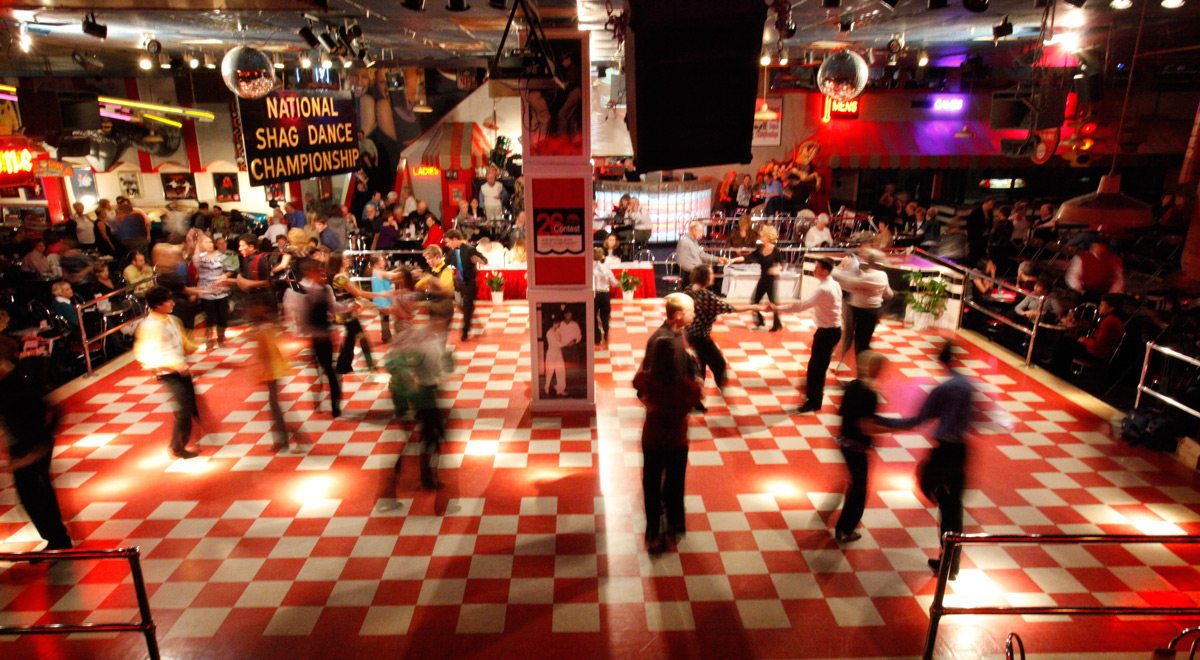
1982
Rock Burger Restaurant & Bar opens. This local hangout was known as one of the area’s only after-hours clubs for many years.
The Castle Dracula haunted house on Ocean Boulevard closes.

Several places have carried the Rock Burger moniker over the years, including a short-lived restaurant in 2014.
1983
Openings include Sands Ocean Club in Myrtle Beach and Oyster Bay Golf Links, just north of the border in Sunset Beach, N.C.
The Annual Craftsmen’s Classic Art & Craft Festival held for the first time and Magic Harbour Amusement Park closes.

1984
Pier 14 Restaurant & Lounge opens for business as a nightclub and a late night hangout, later becoming a restaurant under new ownership in 1986.
Other restaurant openings include Nibil’s Oceanfront Dining at Surfside Pier and Bodo’s German Restaurant in Myrtle Beach.
The National Shag Dance Championships are held for first time in Myrtle Beach and The Afterdeck Nightclub opens on Feb. 29, 1984.

1985
Myrtle Waves water park celebrates its inaugural season. Over the past 30 years, the park has grown from just a few slides to a 20-acre waterpark with popular slides such as the Arooba Tooba, Night Flight and Rockin’ Ray.
In addition, the Palace Resort and Aqua Beach Inn open in Myrtle Beach.

1986
The Carolina Opry, the area’s longest running theater show (), opens in Surfside Beach. The show would later move to its current home, the Calvin Gilmore Theatre in Myrtle Beach in 1992.
The Ocean Forest Plaza and Beach Colony Resort hotels open in the “Cabana District” area of Myrtle Beach, while Embassy Suites Myrtle Beach Oceanfront Hotel and Resort opens at Kingston Plantation.
The Heritage Club golf course opens in Pawleys Island.

1987
A trio of hotels, Myrtle Beach Resort and The Breakers Resort and Bay Watch Resort open in Myrtle Beach.
Myrtle Beach Blue Jays Single-A Baseball Team plays its inaugural season.
Main Street North Myrtle Beach sees changes with the addition of Judy’s House of Oldies, a record store and gift shop, and the closure of The Pad, a long-running shag dance club.
In Conway, the Rivertown Music & Arts Festival held for the first time.

1988
Barefoot Landing shopping and entertainment complex and Myrtle Beach Tours, a popular rental company for spring breakers, both open in North Myrtle Beach.
In Myrtle Beach, additions include Angelo’s Steak & Pasta and resorts including Atlantica Resort and Patricia Grand.
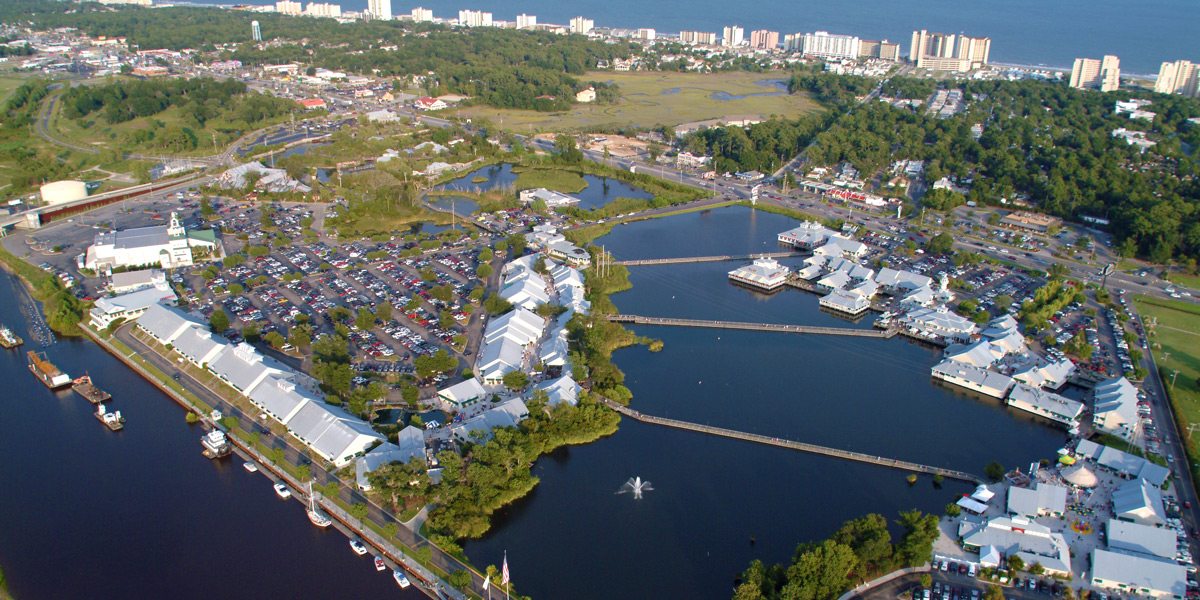
1989
Hurricane Hugo hits the Grand Strand. The category 4 storm killed 27 people in South Carolina, left nearly 100,000 homeless, and resulted in $10 billion in damage overall, making it the most damaging hurricane ever recorded at the time.
One of the area’s most popular restaurants River City Cafe opens its first location in Myrtle Beach.
The first North Myrtle Beach St. Patrick’s Day Parade is held and Calvin Gilmore, owner of The Carolina Opry, opens a second show called The Dixie Jubilee also in North Myrtle Beach.

The 1990s
Baseball, Broadway, Blues & a theater boom
The oceanfront landscape really came into shape in the 1990s, with construction crews working full-time to build many high-rise hotels, resorts, motels and condo complexes near the beach.
The addition of many live entertainment theaters would have dominated the attractions news of the decade if not for an ambitious $250 million project from Burroughs & Chapin Co. (), an entertainment complex that would come to be known as Broadway at the Beach. Though some considered it a gamble to try and draw visitors away from the beach, the complex soon became a hub of entertainment and tourism in the area, being named “Top Tourist Attraction” in South Carolina at the Governor’s Conference on Travel and Tourism.
Though growth and modernization continued to change the look of the Myrtle Beach area, there were efforts during this era to keep the “family-friendly” image of Myrtle Beach, including the infamous 1993 “thong ordinance” which threatened fines or jail time for swimwear that exposed any portion of the buttocks.
1990
Golf courses including Tidewater Golf Club in Little River and Legends Golf & Resort, a multi-course resort off of U.S. 501 near Carolina Forest, open for business.
Wild Water & Wheels water park opens in Surfside Beach. Over the years, the park has grown to a 16-acre park with 24 slides, a wave pool, mini golf, go-karts and more.
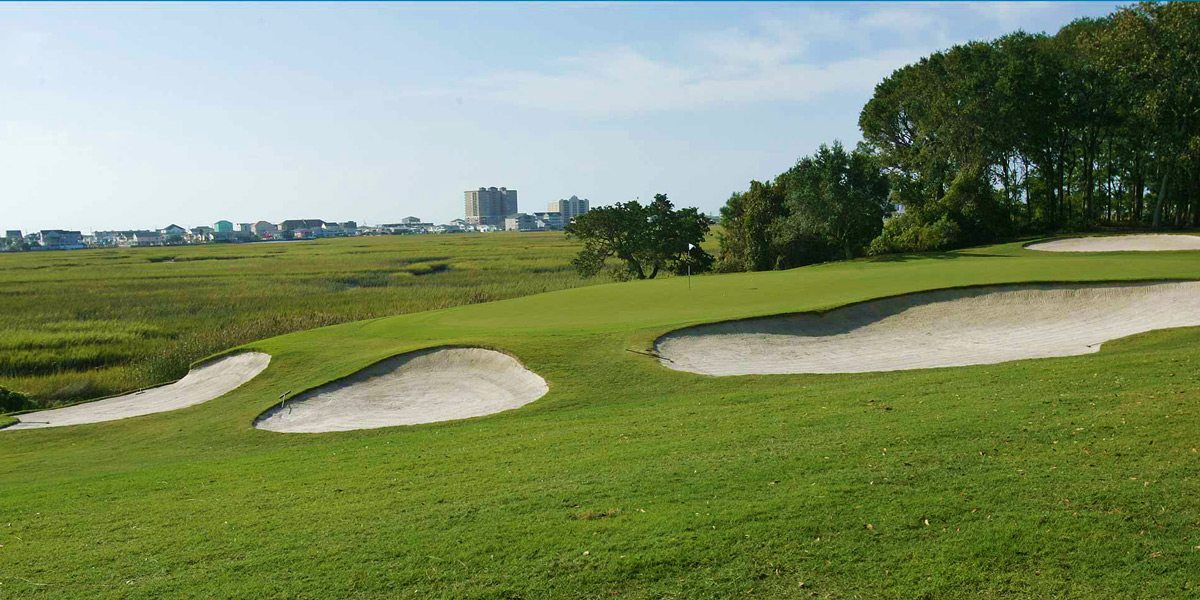
1991
The Myrtle Beach Blue Jays baseball team is renamed to the Myrtle Beach Hurricanes () before being sold after the 1992 season and moved to Maryland.
Pawleys Island Festival of Music & Art is held for first time. Beginning with “Eine Kleine Nachtmusick,” a Mozart Bicentennial Celebration, the festival has grown into a 3-week event each fall which features chorale, blues, Beach, jazz, symphony, bluegrass, gospel and spiritual music, as well as art, food and fashion events and fundraisers.
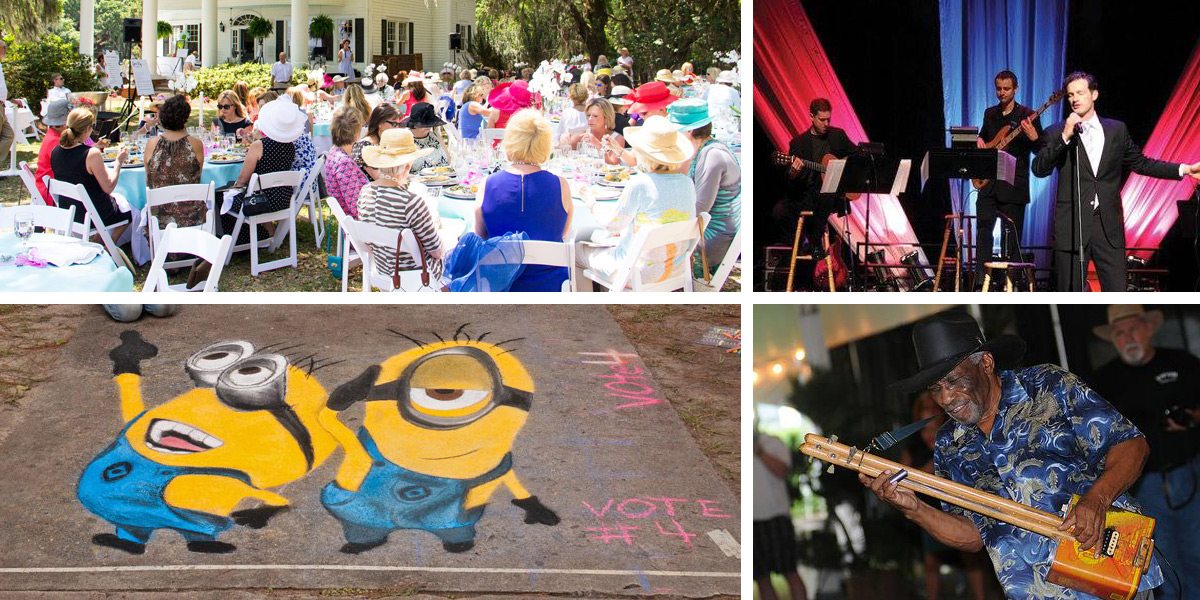
1992
The Calvin Gilmore Theatre, new home of the Carolina Opry, and Dolly Parton’s Dixie Stampede, open side-by-side on the north end of Myrtle Beach.
Dick’s Last Resort restaurant opens at Barefoot Landing.
After more than 60 years in business, Chapin’s Department store in downtown Myrtle Beach closes.

The Calvin Gilmore Theatre • Source: The Carolina Opry
1993
As the theater boom begins to expand, Alabama Theatre Myrtle Beach opens at Barefoot Landing, while the Southern Country Nights show opens in Surfside Beach.
Also in 1993, Mayhem Manor haunted house opens in downtown Myrtle Beach and the Myrtle Beach Air Force Base closes for good.

1994
Several new attractions are added including the Gatlin Brothers Theatre in the Fantasy Harbour area, Caledonia Golf & Fish Club in Pawleys Island, Children’s Museum of South Carolina at Myrtle Beach Mall and Carmike Dunes 8, which replaces the Dunes IV theater in Myrtle Beach.
In restaurant news, The Alabama Grill opens off of U.S. 17 Bypass in Myrtle Beach at a location that would later become Phillips Seafood restaurant (now demolished), while Rivertown Bistro opens in downtown Conway.
Crown Reef Resort on Ocean Boulevard opens for business.

1995
Broadway at the Beach entertainment complex is built in Myrtle Beach. Restaurants including Hard Rock Cafe Myrtle Beach and Tony Roma’s Steakhouse Restaurant open there, as well as attractions including Palace Theatre Myrtle Beach. Bullwinkle’s Family Food & Fun restaurant opens nearby on 29th Avenue North.
Several new theaters open with Medieval Times, Ronnie Milsap Theater and Ice Castle Theater () opening in the Fantasy Harbor area of Myrtle Beach and Legends In Concert moving into the former Carolina Opry building in Surfside Beach.
In North Myrtle Beach, the Carolina Beach Music Awards are held for the first time and Pirate’s Cove Loungeopens on Main Street. Rock Burger Restaurant & Bar in Myrtle Beach closes.

1996
Hurricane Fran, a Category 3 storm with winds up to 115 mph came near Horry County on Sept. 5, 1996, before weakening slightly and making landfall near Cape Fear in North Carolina on Sept. 6. In Myrtle Beach, winds were recorded up to 77 mph and many trees downed leaving nearly 60,000 residents without power.
Planet Hollywood restaurant and the Official All-Star Cafe open side-by-side in Myrtle Beach. Celebrities including Bruce Willis, Patrick Swayze, Monica Seles, Will Smith, Dan Cortese, Jennifer Love Hewitt, Luke Perry, Tiger Woods, Andre Agassi, Joe Montana and Ken Griffey Jr. attended the grand openings. Man ‘O’ War golf course opens off of U.S. 501 west of Myrtle Beach.

1997
House of Blues Myrtle Beach opens at Barefoot Landing with a May 4 ceremony featuring appearances from The Blues Brothers — Dan Aykroyd, James Belushi and John Goodman — as well as R&B legend James Brown. Early performances at the new concert hall included The Wallflowers, Erykah Badu, Johnny Cash, ZZ Top and Widespread Panic, who performed on July 7, 1997.
In Myrtle Beach, The short-lived Ronnie Milsap Theater closes.
Ripley’s Aquarium of Myrtle Beach opens its $36 million, 74,000 sq. ft. facility at Broadway at the Beach. Franklin G. Burroughs-Simeon B. Chapin Art Museum opens in the former “Springmaid Villa” located near Springmaid Pier on the south end of Myrtle Beach.

1998
Myrtle Beach Marathon runs it inaugural race with the old Air Force Base on Farrow Parkway as the setting. The February race draws 2,400 participants across two events and Olympic gold medalist Gwenn Torrence participates as a celebrity host.
NASCAR Speedpark and NASCAR Cafe open with appearances from racing legends Cale Yarborough and David Pearson. Other new additions include True Blue Plantation golf course in Pawleys Island, Crabby Mike’s Seafood in Surfside Beach, Grande Shores Oceanfront Resort and New South Brewery, which was founded in 1998.
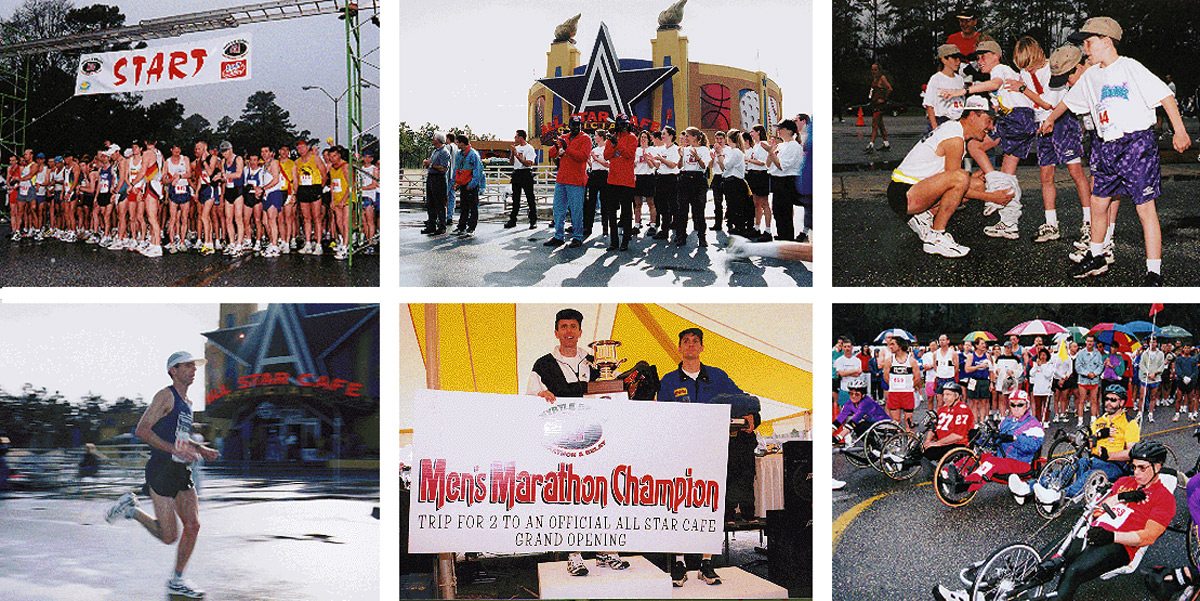
1999
Hurricane Floyd, a category 3 storm with winds up to 115 mph, comes through the area causing widespread flooding throughout Grand Strand. In other news, Mayhem Manor haunted house closes and Sailfish Resort opens near downtown Myrtle Beach.
Myrtle Beach Pelicans, formerly known as the Durham Bulls and the Danville (Va.) 97s, play their Inaugural season in Myrtle Beach as a Class-A affiliate of the Atlanta Braves at Coastal Federal Field near Broadway at the Beach.
In golf news, openings include Wild Wing Plantation in Myrtle Beach, TPC at Myrtle Beach in Murrells Inlet and Mt. Atlanticus Minotaur Goff in downtown Myrtle Beach. Gator Hole golf course in North Myrtle Beach closes, making way for the Gator Hole shopping center which opens later that year.

The 2000s
21st century brings Marshwalk, malls and a failed theme park
In many ways, the new millenium marked a changing of eras for the Myrtle Beach area.
Needing to keep pace with a changing, post-9/11 world where vacation planning became an online experience, the area made many efforts to modernize, which included the closing of many outdated businesses and attractions, including the beloved Myrtle Beach Pavilion Amusement Park.
As the housing bubble inflated, few places were more affected than the Grand Strand, which saw borderline-absurd levels of new construction and skyrocketing home prices as more and more Northerners looked to escape our warm, Southern shores. As the bubble burst, and recession hit, not only did many homeowners and builders get caught in tough financial situations, but plans for many new developments and attractions were scrapped.
Though some projects, such as Hard Rock Park and The Market Common were completed, many of the attractions and other businesses built during the late 2000s struggled to survive under the weight of a tough economy.
2000
Murrells Inlet Marshwalk is built, paving way for the opening of popular restaurants such as Creek Ratz of Murrells Inlet in 2000 and Dead Dog Saloon in 2001.
In Myrtle Beach, the last NASCAR Busch Series race, The Myrtle Beach 250 (), is held at Myrtle Beach Speedway on June 17.
Barefoot Resort simultaneously opens four championship courses designed by golf legends including Greg Norman, Davis Love III, Tom Fazio and Pete Dye. The Barefoot Landing Swing Bridge opens in March to provide access to the new golf resort.
A pair of new hotels, Paradise Resort and Sandy Beach Resort open oceanfront along South Ocean Boulevard in Myrtle Beach. Bon Villa Ocean Front Motel closes. Property is now Sharkey’s Beach Bar.
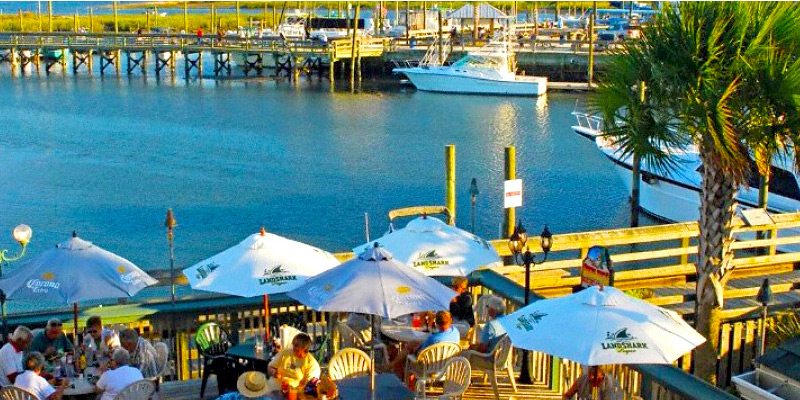
The Murrells Inlet Marshwalk
2001
The Waccamaw Pottery company ceases operations. The original Waccamaw Pottery building had anchored the Waccamaw Factory Shoppes complex, once the nation’s third-largest outlet shopping complex.
Also in Myrtle Beach, Grande Dunes Resort Club golf course opens for business. This lush and elegant golf course accompanied the development of Grand Dunes, a private resort community with luxurious homes, and the nearby Marina Inn, a four-diamond resort on the Intracoastal Waterway.

2002
S.C. Route 31, also known as Carolina Bay Parkway, opens as a six-lane, limited-access highway that parallels the Intracoastal Waterway. The first phase opened on December 17, 2002, completing a 22-mile link between U.S. 501 and S.C. 9.
Sea Mist Oceanfront Resort opens in Myrtle Beach, while the Marsh Harbour and Ocean Harbour golf courses in nearby Calabash, N.C., announce their closure.
2003
The Inaugural Irish-Italian International Festival is held in North Myrtle Beach.
The first South by Southeast Music Feast event is founded to preserve and promote American music not usually heard in traditional venues.
Ocean Reef Resort opens on North Ocean Boulevard in Myrtle Beach. Robber’s Roost golf course in North Myrtle Beach closes.
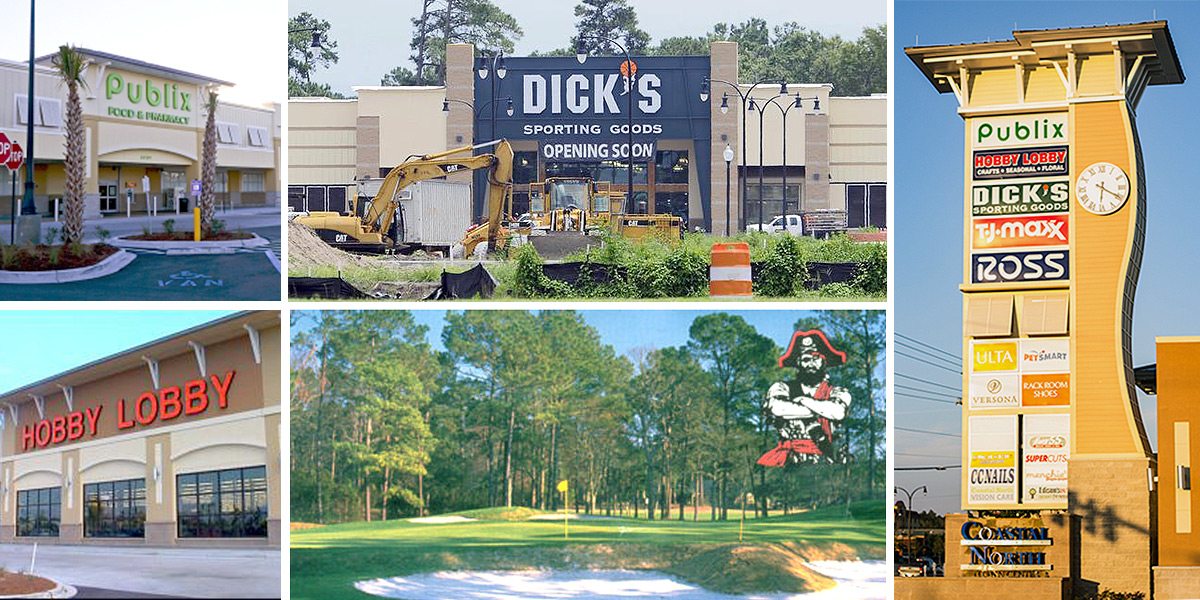
2004
Local shopping gets a boost with the opening of Coastal Grand Mall, a one-level regional mall with more than 1 million square feet of retail space () and the first of two Tanger Outlets locations in Myrtle Beach.
Openings include Jimmy Buffet’s Margaritaville restaurant at Broadway at the Beach, Calvin Gilmore presents Tribute! The Concert in North Myrtle Beach, Margate Tower at Kingston Plantation, Carolinian Beach Resort in Myrtle Beach and a newly-renovated Myrtle Beach Train Depot — used for weddings, concerts and special events.
Closures in the area include Mother Fletcher’s nightclub in downtown Myrtle Beach, Dunes Carmike Cinema 8on Kings Highway, Bullwinkle’s Family Food & Fun near Broadway at the Beach, Belle Terre golf course in Myrtle Beach and Calabash Golf Links in Calabash, N.C.

2005
With many of its tenants moving across town to Coastal Grand Mall, Myrtle Square Mall closes in the fall of 2005.
Other closures are The Pink House, an inn, restaurant and holiday shop open since 1947, and several golf courses including Angel’s Trace Golf Links in Calabash, N.C., Burning Ridge West, Raccoon Run and Winyah Bay golf course in Georgetown.
MagiQuest, an attraction which puts visitors into a fantasy-themed live action role playing game, opens at Broadway at the Beach. Other new additions include The Boathouse Waterway Bar & Grill on the Intracoastal Waterway, The Reserve at St. James Plantation golf course in Southport, N.C., Mayfest on Main a live music event and festival and Avista Resort in North Myrtle Beach.
Also, after more than 30 years of being known for serving the strongest drinks in the nation () due to a state law that required bars to serve liquor from mini bottles, South Carolina abolishes the law in 2005. It officially ends on New Year’s Day 2006.
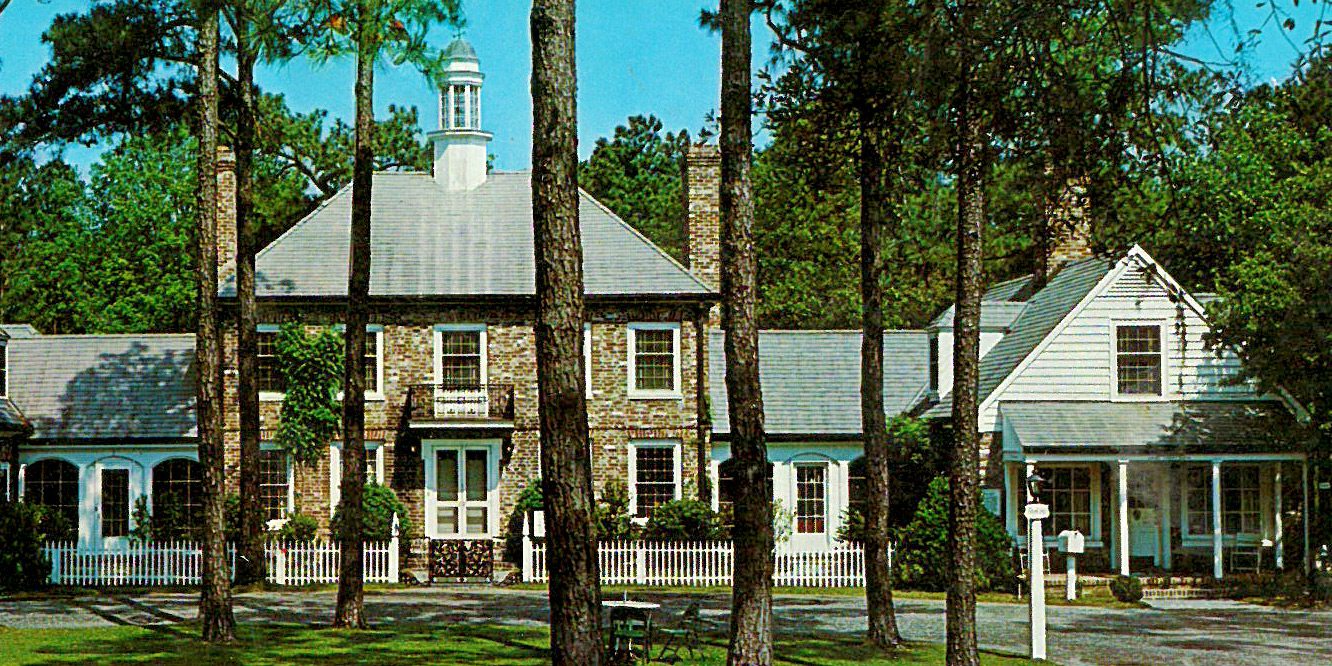
2006
Burroughs & Chapin announces that the Myrtle Beach Pavilion Amusement Park will close at the end of the season. The park’s “final ride” event is held on Sept. 30, 2006 ().
Other closures include Grand Prix Family Thrill Parks in North Myrtle Beach, Santa Fe Station restaurant in North Myrtle Beach and The Freaky Tiki night club in downtown Myrtle Beach.
KISS Coffeehouse opens at Broadway at the Beach with a grand opening attended by founding band members Gene Simmons and Paul Stanley. Other new additions include the Sling Shot oceanfront thrill ride in Myrtle Beach and the first-ever Beach, Boogie & BBQ Festival held over Labor Day weekend.
Several resorts and condominium complexes including Paradise Resort, Anderson Ocean Club and Carolina Grande open on North Ocean Boulevard in Myrtle Beach, while Bay Tree Plantation is built in North Myrtle Beach.

Scenes from “The Last Ride” at the Myrtle Beach Pavilion on Aug. 30, 2006 • Source: Youtube user mulchpuppy
2007
Relocating some of the most popular attractions from the Myrtle Beach Pavilion Amusement Park, the Pavilion Nostalgia Park opens at Broadway at the Beach.
Other openings and renovations include Bay View Resort, an oceanfront luxury resort in Myrtle Beach and Hilton Royale Palms resort and condo complex in North Myrtle Beach.

2008
The Market Common, an upscale, open-air shopping center opens on the former Myrtle Beach Air Force base. The opening of this complex includes the arrival of restaurants such as Gordon Biersch, Travinia Italian Kitchen, P.F. Chang’s and King Street Grille as well as attractions like Grand 14 Cinema, Grand Park and Warbird Park, as well as retail spots like Williams & Sonoma and Barnes & Noble.
With planning beginning in 2003 and construction starting in 2007, the $385 million Hard Rock Park opened it doors on June 2, 2008, featuring a signature roller coaster Led Zeppelin: The Ride and six rock-themed areas. After lower-than-expected attendance in the park and the loss of financial backing, the park closed a month earlier than expected and filed bankruptcy in September.
New additions include the Carolina Improv Company, The Big M Casino Boat in Little River, Oceans One Resort in Myrtle Beach and the first-ever Myrtle Beach Military Appreciation Days, a month-long celebration of veterans and active duty military members in May. In other news, NASCAR Cafe restaurant closes for business.
The Town of Surfside Beach passes the area’s first ban on smoking in indoor places. City of North Myrtle Beach would later follow suit passing an ordinance in 2012 banning smoking in restaurants, bars, public places, work places and some outdoor facilities.

2009
The former Hard Rock Park is purchased for $25 million () and opens as Freestyle Music Park on May 23. Despite reduced admission and a few small additions to the park, the park failed to gain the traction it needed. After several lawsuits and a lack of further investors, it failed to open for business for the 2010 season.
Having opened in 1927, “The Granddaddy” of Myrtle Beach golf, Pine Lakes Country Club, undergoes a multi-million dollar renovation with a new clubhouse and revised course layout. Also in Myrtle Beach, the first Ocean Boulevard’s Oktoberfest celebration is held downtown.
Several new restaurants open around the area including Fibber’s On The Water in Little River, Crafty Rooster in downtown Conway and Jimmyz Original Hibachi House and Big KT’s BBQ Shack in Myrtle Beach. Club Kryptonite, a dance club located in the former All-Star Cafe building off of U.S. 17 Bypass, closes.

The 2010s
New boardwalk booms as Broadway turns 20
As the decade turned to modern day, Myrtle Beach emerged from the malaise caused by the recession’s closures and failed attractions with a new determination.
After breaking ground in the fall of 2009, the $6.4 million Myrtle Beach Boardwalk and Promenade was completed in 2010, breathing life into a downtown area which had been without an identity since the Pavilion closed.
The Myrtle Beach Skywheel was added in 2011, making the area surrounding the boardwalk again one of the most popular parts of Myrtle Beach just in time for the city’s 75th birthday celebration in 2013 ().
Now, as we enter the latter half of this decade, the area continues to grow with the addition of many new businesses, events like the Carolina Country Music Festival, and improvements to the downtown infrastructure.
Around the Grand Strand, additions such as the Myrtle Beach Sports Center, North Myrtle Beach Sports & Recreation Complex, Coastal North Town Center in North Myrtle Beach and continued development at The Market Common, showcase the coast’s continued growth.
2010
The Myrtle Beach Boardwalk and Promenade opens. This 1.2-mile walkway is made up of three sections and stretches from 14th Avenue North to 1st Avenue North in Myrtle Beach. The first-annual Ocean Boulevard’s St. Patrick’s Day Festival is held near the boardwalk in downtown Myrtle Beach.
Other additions include Soar + Explore ropes course and zipline at Broadway at the Beach, Fun Warehouse, a skating rink and arcade near Surfside Beach and SunCruz Casino cruises in Little River. North Beach Plantation, an upscale beach resort with Georgian architecture and a tropical motif opens in North Myrtle Beach.
Legends In Concert tribute show moves to a state-of-the-art theater near Broadway at the Beach (formerly All-Star Cafe and Club Kryptonite). Dolly Parton’s Dixie Stampede dinner show closes with announcement that it will be replaced by a Pirate-themed attraction.
A pair of Myrtle Beach nightlife spots — Studebaker’s dance club and The Beachwagon country music bar — close their doors.
Several new restaurants open including Ultimate California Pizza Game Zone on Restaurant Row, Midtown Bistro in North Myrtle Beach, Flying Fish Market & Grill at Barefoot Landing and Nacho Hippo at The Market Common and Mykonos in Myrtle Beach.
After 23 years in business atop Surfside Pier, Nibil’s restaurant closes its Surfside location over a leasing dispute with the Town of Surfside Beach.
Other restaurant closures include 5 O’Clock Somewhere in Myrtle Beach and Tony Roma’s Steakhouse Restaurant and Uno Chicago Grill at Broadway at the Beach.

2011
Myrtle Beach Skywheel opens in downtown Myrtle Beach. When it opened, the 187-foot tall structure was the second-tallest in the U.S. and the tallest of its type east of the Mississippi River. The Jimmy Buffet-owned restaurant Landshark Bar & Grill opens underneath the SkyWheel.
New Things to do include Wonderworks Myrtle Beach at Broadway at the Beach, Pirate’s Voyage dinner show and Bodies Revealed medical exhibit.
Also opening is Tilted Kilt Pub & Eatery at Broadway at the Beach and Mar Vista Grande resort in North Myrtle Beach.
The Pat Boone Theatre is scheduled to open at former NASCAR Cafe location, but is repeatedly delayed and eventually abandoned.

2012
The Myrtle Beach Area Chamber of Commerce cancels the Sun Fun Festival (), the area’s longest-running festival, after 60 years citing the event’s inability to pay for itself as it had in past years.
Another piece of Myrtle Beach history, Chesterfield Inn demolished to make way for a miniature golf course.
Myrtle Beach Adrenaline Adventures Zipline opens on the former Myrtle Beach Pavilion Amusement Park site. Also opening are Backstage Mirror Maze and The Lazer Vault Maze at Broadway at the Beach and Sayebrook Town Center near Surfside Beach — a shopping center which includes Target, Marshall’s, Petco and several restaurants.
Bandito’s Mexican Cantina opens oceanfront near the Myrtle Beach boardwalk. The owners of the restaurant then pay to have the 1.2-mile boardwalk extended an extra block north to end at Bandito’s. Other new restaurants include Moe Moon’s and 8th Avenue Tiki Bar & Grill on the Myrtle Beach Boardwalk, Rodeo Bar & Grill at Broadway at the Beach and Surf Diner opens at the Surfside Pier.
A fire destroys Dead Dog Saloon in February; however, the restaurant reopens bigger and better after a renovation later that summer. Another fire, at Time Out! in downtown Myrtle Beach causes the long-running gay bar and nightclub to close after heavy damage to the building.
Other closures include Cagney’s Old Place — after 36 years in business — Spud’s Waterfront Dining at the Murrells Inlet Marshwalk, Mykonos Greek restaurant and nightclub in Myrtle Beach, Phillips Seafood in Myrtle Beach and IMAX Myrtle Beach at Broadway at the Beach.

The Myrtle Beach Adrenaline Adventures Zipline now runs over the lot where the Pavilion once stood.
2013
City of Myrtle Beach celebrates the 75th Anniversary of its incorporation with several events to commemorate the occasion. Also in Myrtle Beach, the Myrtle Beach International Airport opens a brand-new $118 million terminal.
Shark Attack Mini Golf & Hammerhead Grill restaurant open oceanfront in the former Chesterfield Inn location. New additions to the area include I Love Sugar candy shop, Johnny D’s Waffles & Bakery in Myrtle Beach, Wicked Tuna in Murrells Inlet, North Myrtle Beach Historical Museum and, at Broadway at the Beach, Carolina Comedy Club, Encounters: UFO Exhibition and Carmike Broadway 17’s BigD Theater.
Buccaneer Bay Mini Golf near Surfside Beach closes to make way for the area’s first Wal-Mart Neighborhood Market. Other closures include KISS Coffeehouse at Broadway at the Beach and Tommy Bahama Restaurant at The Market Common — though the retail store remains open.

2014
North Myrtle Beach Park & Sports Center opens. The park features a variety of sports facilities including a dog park, playgrounds, a running track and attractions like Go Ape Zip Line & Treetop Adventure and North Myrtle Beach Jetpack Adventures. Also in North Myrtle Beach, Coastal North Town Center opens with occupants including Hobby Lobby, Dick’s Sporting Goods, Panera Bread, TJ Maxx, Petsmart and others.
Beach tent regulations are put into place in Myrtle Beach, North Myrtle Beach & Horry County. Read more about these regulations by clicking here.
New attractions open including Broadway Grand Prix and Hollywood Wax Museum, in the former NASCAR Speedway and NASCAR Cafe buildings respectively. Restaurant openings include CO Sushi at The Market Common, Boom Boom Wine Room, Atlas Tap House, and Fire & Smoke gastropub in Myrtle Beach and Rooster Bar & Grill at Broadway at the Beach.
SunCruz Casino Boat shut down after a two-year lawsuit with Horry County over a $7 per-person fee the boat was to pay the county. Additional closures include Damon’s North Myrtle Beach and Tilted Kilt at Broadway at the Beach.
Biker hangout Suck Bang Blow Four Corners in Murrells Inlet, a venue which had been increasingly used only during Myrtle Beach Bike Week events, is demolished.
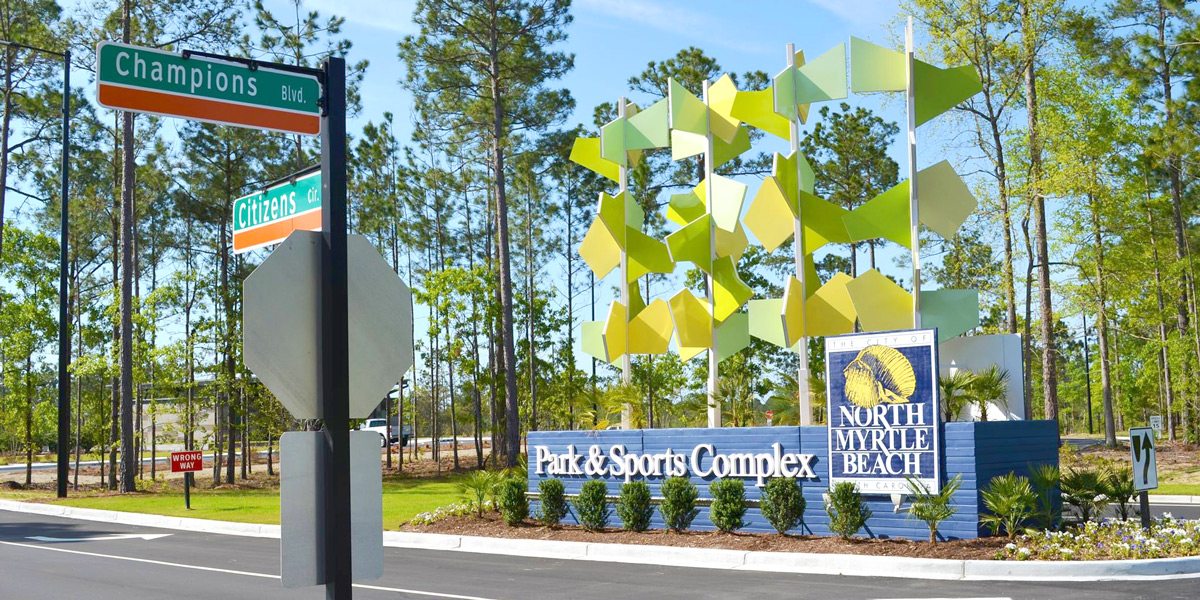
2015
The first-ever Carolina Country Music Fest held on former pavilion site in downtown Myrtle Beach featuring headliners Sam Hunt, Rascal Flatts, Eric Church and Lady Antebellum. The four-day event is the largest outdoor music event ever in Myrtle Beach with nearly 20,000 in attendance.
ART Burger Sushi Bar opens on Myrtle Beach Boardwalk in the spring, with its owners later opening The Chemist: Craft Cocktails & Modern Cuisine nearby in the fall. Other new eateries include Tupelo Honey Cafe at The Market Common, Drafts Sports Bar & Grill at the Westgate Myrtle Beach Resort and The Grumpy Monknear Tanger Outlets.
Several new shops open around the area including Gander Mountain outdoors store near Tanger Outlets on U.S. 501., Carolina Pottery, which takes over the former K-Mart location in Myrtle Beach, and the Paula Deen store at Broadway at the Beach. Myrtle Beach Flea Market closes, but later re-opens under new ownership as Grand Strand Flea Market.
Duplin Winery opens a wine bottling and tasting center near Barefoot Landing, while 710 North Myrtle Beachopens in the renovated location of North Myrtle Beach bowling center. Other new attractions include Dinosaurs: The Exhibition at Broadway at the Beach, Radical Ropes aerial adventure park in Myrtle Beach, Break Out Myrtle Beach in North Myrtle Beach.
The Broadway at the Beach area sees several closures including Planet Hollywood, Magiquest, Carlos ‘N Charlie’s, Club Boca, Rodeo Bar & Grill (as well as its replacement Country Roads Bar & Grill) and Revolutions Nightclub. Restaurants including Broadway Louie’s and Hard Rock Cafe also announce moves and the complex announces the addition of a new craft beer bar/restaurant, American Tap House.
Ocean22 by Hilton Grand Vacations opens in Myrtle Beach — it is the first oceanfront hotel to be built in 7 years.
Closures in the Myrtle Beach area included, Waterway Hills Golf Club, a golf course known for its distinctive gondola over the Intracoastal Waterway, Harold’s On The Ocean, a long-running shag club in North Myrtle Beach, and Bliss, an upscale restaurant in Murrells Inlet.
The so-called “1,000 Year Flood” puts much of the state under water in October. The storm’s toll is estimated to be at least 19 deaths and more than $12 billion dollars damage in S.C. alone. This catastrophic event shut down major highways, canceled numerous events and brought tourism in the Myrtle Beach area to a standstill for several days.

2016
There are many new attractions, events and additions that are planned for the 2016 season in Myrtle Beach.
They include a trampoline park, wakeboarding park, a go-kart track and miniature golf course, events including the California Roots: The Carolina Sessions, Myrtle Beach Highland Games & Heritage Festival, The Horry County Fair and the arrival of several well-known chains including Popeye’s Chicken, Wahlburger’s, World of Beer and Panera Bread.
There is also a major renovation under way at Broadway at the Beach, which includes new restaurants, nightclubs, shops and attractions (Read more or watch the video below).
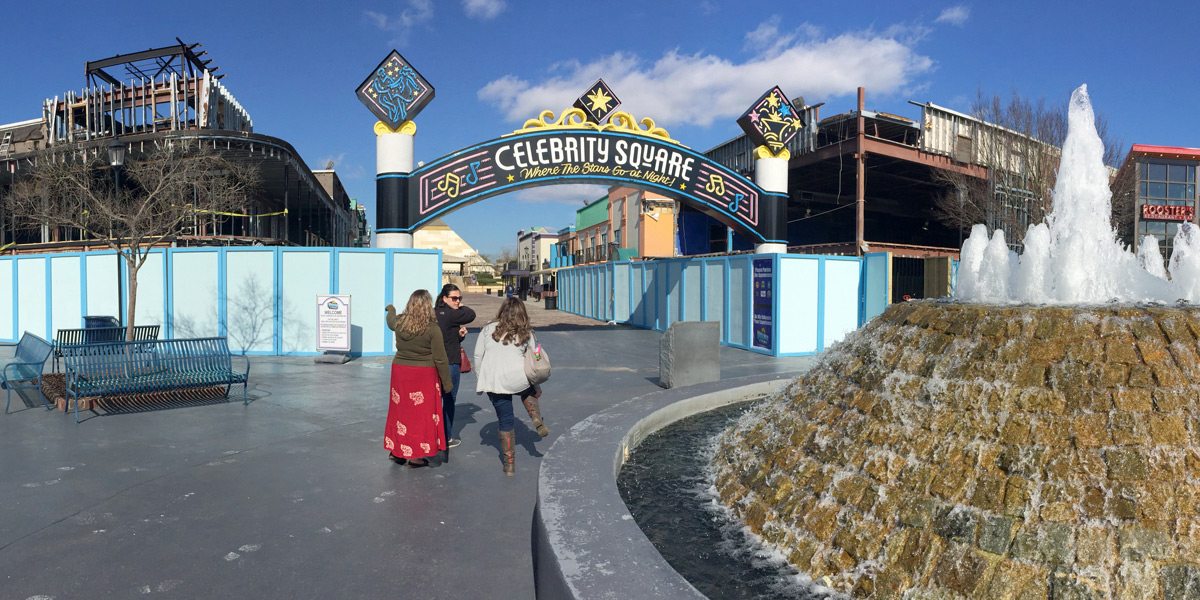
Construction on the new Hard Rock Cafe and American Tap House restaurants at Broadway at the Beach’s Celebrity Square.
2017
Palace Theater closes after damage from Hurricane Matthew put a large hole in the side of the main facade. After sitting vacant and unrepaired for months following the storm, this one-time staple of Broadway at the Beach is demolished beginning in May. Also closing at Broadway at the Beach this year was the Big D movie theater.
But it wasn’t all closures for Broadway, which also saw the addition of huge new Dave & Buster’s where Hard Rock Cafe once sat, and a completely revamped and remodeled nightlife area now known as “The Avenue”.
The local restaurant scene saw the opening of several new hotspots including Paula Deen’s Country Kitchen, Carolina Ale House, Hook & Barrel Restaurant and RipTydz in Myrtle Beach; Hickory Tavern, MOD Pizza, About Thyme and Brisket in North Myrtle Beach; and Flapjack’s, Old Chicago Pizza & Taproom, Blueberry Grill and Inlet Tap Garden on the south side of the Grand Strand.
In golf news, a number of courses saw their demise this year, when Burroughs & Chapin decided to close a pair of pitch-and-putt courses, Midway Par 3 and Cane Patch Par 3, as well as demolishing half of it’s popular Dragon’s Lair mini golf course at Broadway at the Beach (18 of 36 holes are still open). In addition, the short-lived Shark Attack Adventure Golf — located on the former site of the historic Chesterfield Inn — closed this season, after planned expansion of its Hammerhead Bar & Grill halted.
Near the beach, it was announced that Bandito’s Restaurant & Cantina would close in order to make room for a new, larger shopping and entertainment complex at 15th Avenue North on Ocean Boulevard in Myrtle Beach. The restaurant plans to reopen as part of the complex, scheduled to be complete in 2018. Also nearby, construction began on a new high-rise hotel in Myrtle Beach, called Ocean 16 Hilton Hotel, which will be 550,000 square feet with 26 floors and 300 rooms when complete.
Finally, Myrtle Beach saw a lot of change with the south side of oceanfront Myrtle Beach getting a facelift. Plans have been proposed to build new duplexes, a high-rise hotel, a Walmart, and more, around 14th avenue south.

About this Myrtle Beach History Timeline
Recent Posts
- 24 Mar 20252025 Embassy Pool Memberships
- 01 Mar 2025April Events 2025
- 17 Feb 2025Marshwalk Restaurant Week
- 12 Feb 2025Mardi Gras 2025
- 05 Feb 2025Valentine’s Day Myrtle Beach
- 22 Jan 20252025 Lobby Renovation
- 01 Jan 2025Myrtle Beach Facts Trivia & History
- 18 Dec 20242025 Homeowners New Year’s Day Brunch
- 01 Dec 20242024 Christmas & Holiday Events
- 01 Nov 20242024 November/Thanksgiving Events & Dinner
- 11 Oct 2024Myrtle Beach October/Halloween Events 2024
- 01 Sep 2024Hurricanes in Myrtle Beach
- 08 Aug 2024Planning For Emergencies Hurricanes/Tornados/Storms
- 01 Jun 2024July Events 2024
- 01 May 2024Myrtle Beach PGA Tour 2024
- 18 Apr 2024Kingston Plantation Owners
- 01 Apr 2024Spring Break 2024
- 01 Mar 2024St Patrick’s Day Myrtle Beach
- 01 Feb 2024Myrtle Beach Valentine’s Day 2024
- 01 Feb 2024Super Bowl
- 28 Jan 2024Spanky’s Polar Plunge
- 01 Jan 2024Myrtle Beach History
- 21 Dec 2023The Great Christmas Light Show
- 01 Dec 2023New Year’s Eve 2023/2024
- 24 Nov 2023Christmas Regatta/Yachts For Tots
- 12 Nov 2023Thanksgiving Day Dining
- 04 Nov 2023Coats for Kids Golf Cart Rally 2023
- 01 Oct 2023Halloween 2023
- 01 Sep 2023Myrtle Beach Hurricanes
- 01 Aug 2023Labor Day Weekend 2023
- 01 Jul 20232023 Myrtle Beach Tide Chart
- 06 Jun 20232023 July 4th Fireworks
- 26 May 2023June 2023 Myrtle Beach Events
- 17 Apr 2023Taste Of The Market Common
- 07 Mar 2023Myrtle Beach in April
- 19 Feb 2023National Fire Protection Association Dryer Vents
- 25 Nov 2022Coats For Kids Golf Cart Rally
- 02 Oct 2022Myrtle Beach/Horry County Laws & Rules
- 08 Aug 2022Myrtle Beach City, SC Population
- 01 Jul 2022Myrtle Beach in July
- 01 Jun 2022Myrtle Beach July 4th Celebration
- 01 May 2022Myrtle Beach May Events
- 06 Mar 2022Myrtle Beach St. Patty’s Day
- 01 Mar 2022Myrtle Beach Easter
- 01 Feb 2022MarshWalk Murrell’s Inlet Restaurant Week
- 07 Nov 2021Thanksgiving Dinner 2021
- 01 Oct 2021Myrtle Beach October Events 2021
- 12 Aug 2021Broadway at the Beach New Additions
- 12 Aug 2021Barefoot Landing 2021 Season
- 12 Aug 2021Embassy / Hilton Resort Renovation
